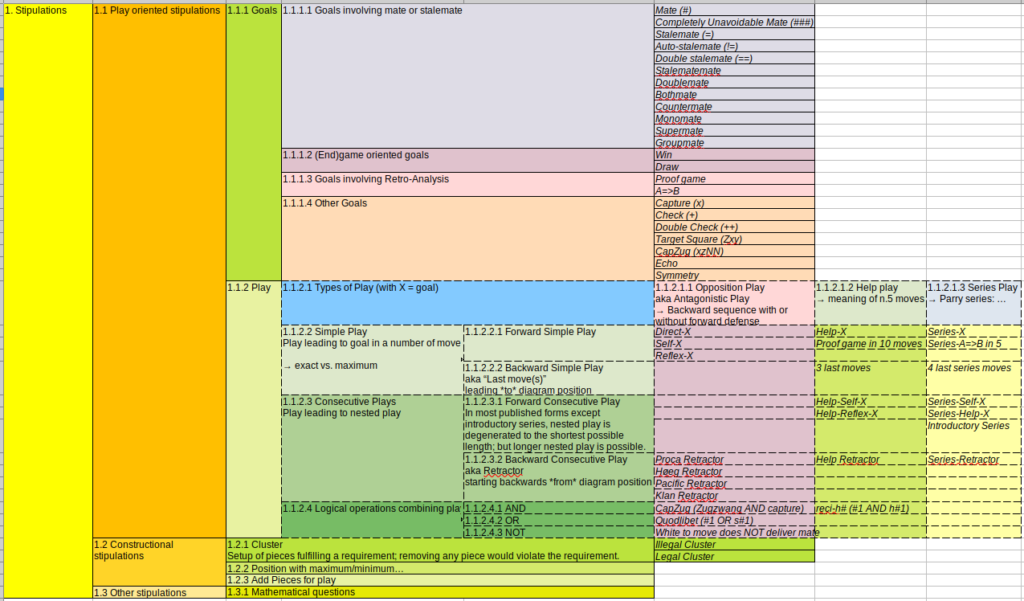
The FCCP – March 2022 Update
After the initial release in April 2021, the last release in August 2021 covered some 476 elements. No updates to the database have since been made. This was mainly due to our decision to implement a new format wherein alternative classification choices could be shown together. While this “Grand Unified Theory” is still under progress, we are happy to present some new classification ideas by Thomas Maeder, Maryan Kerhuel and Chris Tylor. These will, hopefully, be eventually integrated into our GUT!
- Back in May 2021, Thomas Maeder proposed a classification model for the Stipulations group. It used a two-dimensional matrix for the “Play” group. His original outline is here and a slightly modified and coloured version by NSR is here.
- Maryan Kerhuel started work on a classification model for the Conditions group from October 2021. He has included the relationship between conditions and piece attributes. His latest version can be seen here (Group and sub-group definitions) and here (Spreadsheet with 300+ conditions from WinChloe sorted by name [sheet 1] and by classification code [sheet 2]).
- After a break, Chris Tylor returned to the project from February 2022, with a comprehensive document covering all the existing plus some new elements and attempting a different approach, which can be seen here. Chris’s words from the introduction: “…I would like to dedicate it and any further versions to Julia – as being the person with the vision to set this project in motion in the first place.”
– NSR on behalf of FCCP team



Wow! Many interesting ideas and amazing work by Shankar
Sorry! The ideas and work are all by Thomas, Maryan and Chris. I only put their documents together for Julia to publish.
Moved and deleted.
For those readers who may be new to the concept of Fairy Chess, a short introduction is advisable:
Fairy Chess is the name commonly used for board games similar to Chess or inspired on Chess that are different from standard European Chess, and from other traditional and geographically located games that are probably derived from the same common ancestor from which European Chess itself derives.
Most Chess historians believe that the ancestor was Chaturanga, a game invented in India perhaps about the fifth century after Christ. Chaturanga was played on a board called Ashtapada, previously used for a race game. The race game may have evolved into the modern Parcheesi, or Ludo, played with dice, while Chaturanga probably evolved into games played in various countries in past times, or until today, such as Burmese Sittuyin, Siamese Makruk, Cambodjan Ouk, Chinese Xiangqi, Korean Jangqi, Japanese Shogi, Persian Chatrang, Arab Shatranj, and others. European Chess is, undoubtedly, derived from Arab Shatranj.
Varieties of those games have always existed. A variety of Arab Shatranj called Juego de Donzellas (Game of Damsels) appears in the famous manuscript of King Don Alfonso of Castille, finished in the year 1283.
Gradually, a variety becomes different enough and widely accepted, and it receives name as a new game. Two or more varieties may coexist for some time, frequently played in the same or in different regions. As it happens to dialects and languages, one may be considered more official or orthodox than the others, but the unofficial or heterodox one may enjoy greater acceptance in a region. Shatranj evolved into different varieties in different regions of Europe. Zatrykion was played in Greece, Grande Axedrez was played by the nobility of the Iberian Peninsula, Courier was played in Germany until the Modern Age, and other examples.
A variety of recent invention or obscure origin, not usually considered traditional, is called ‘Fairy Chess’.
Classification of Fairy Chess varieties is difficult, but it has been attempted with more or less success. In Julia’s Fairies there are two, the oldest is the Fairy Chess Terms Data Base, by Lady Julia Vysotska. It is a searchable data base of variety names and their descriptions, developed mainly between 2013 and 2020:
https://juliasfairies.com/fairy-terms/jf-fairy-terms/
The newest is the Fairy Chess Classification Project. It comprises three main efforts by Thomas Maeder, Maryan Kerhuel and Chris Tylor, with suggestions by other members of Julia’s Fairies, all coordinated by Mister Shankar Ram. It was initially developed from April to August 2021, then retaken in February 2022:
https://juliasfairies.com/fairy-terms/fairy-classification-project/
It is a work, because there are THOUSANDS of Fairy Chess varieties. More than forty thousand are known, though many differ in only minor details. The Chess Variants site has about fifteen hundred playable via Game Courier, but counting descriptions that lack a play preset, the number goes over eight thousand.
Anyone can invent a new variety simply by changing rules, pieces, board, or play goals of Chess or another game, and two players may play that variety without publishing their invention. Nonetheless most varieties can be classified into related groups, and it is this taxonomic task that the ‘chessologist’ intends to do.
Like a linguist classifying languages and dialects, or a biologist classifying species and races, it is also possible to classify varieties of Fairy Chess. The main problem is the choice of characteristics taken as the basis for comparison. As example, pterodactyla, bats, birds and many insects have wings, but they are not related. Likewise, two varieties of Chess may have elements in common, but they may be too different in some FUNDAMENTAL characteristic, thus deserving to be classified in different groups. Or the opposite.
In his ‘Taxonomy of Chess Variants’ Mister Michael Keller lists the following fundamental characteristics. He includes for example Japanese Shogi or European Chess as varieties, which makes taxonomical sense.
There are sports like Chess Boxing, where competitors alternate rounds of Chess with rounds of Boxing. It is a combined sport more than a variety, because they play standard European Chess and not Fairy Chess.
More information available in Wikipedia and other Internet sites. There are Web servers where many Fairy Chess varieties can be played against human opponents or computers. The biggest one is Chess Variants.
https://en.wikipedia.org/wiki/Fairy_chess
https://en.wikipedia.org/wiki/Fairy_chess_piece
https://en.wikipedia.org/wiki/List_of_chess_variants
https://www.chessvariants.com/play/pbm/logs.php?
Members of Julia’s Fairies are invited to study the documentation hyper linked above, and to suggest ideas or corrections to Lady Julia Vysotska for the Data Base, or to Mister Ram for the Classification Project.
Members who wish to play Maidens Chess, variety invented by me, are invited to open an account in Chess Variants. Maidens Chess is like European Chess, but a piece that can capture should capture, or risk being huffed out of the board at the next turn. This makes Maidens Chess VERY different from European Chess.
https://www.chessvariants.com/play/pbm/play.php?game=Maidens+Chess&settings=maidens
Dixieland for ever !
P. A. Stonemann, CSS Dixieland
Must capture is a very old condition. So nothing new about Maiden chess. When the condition is “must capture” where is the question of any piece skipping it ?
The expressions ‘must capture’, ‘should capture’, ‘has to capture’, or similar words, may refer to either one of two very different meanings.
The most common meaning is the ABSOLUTE obligation of capturing. In this sense, a piece that is presented with the possibility of capturing has the legal obligation of capturing, the game just cannot continue without making that capture. There are situations in which a piece is presented with more than one capture, situations in which more than one piece can capture the same opponent, and situations that combine both options, capturing more than one opponent and capturing with different pieces.
In these cases the rules are different in different games or varieties. In some the choice of capturing is completely free, in others there are rules of priority for capturing, based on the hierarchy of the capturable pieces or on the hierarchy of the capturing ones. In some variety all possible captures are allowed in the same turn. The player has legal obligation of following rules of priority, if any, but captures are always MANDATORY in those games or varieties, they cannot be forfeited, passed or avoided.
That is the case of Losing Chess, Suicide Chess, and other varieties of Chess where the goal is to lose all pieces. In some varieties including the king, who is capturable in those varieties. The player who has lost all his pieces or who is in situation of stale mate, is the winner of the game.
That is also the case in some varieties of the game of Draughts, where capturing cannot be rejected, it is a legal obligation in those varieties.
By contrast, there is a second meaning of ‘must capture’ or of similar expressions. This second meaning is the common one in most varieties of Draughts, but paradoxically, it is the UNCOMMON meaning in most varieties of Chess. This is why You are confused, Mister Seetharaman Kalyan. In fact, You are ALWAYS confused. With Mister Shankar Ram, with me, and with nearly every other member in Your hasty comments.
The second meaning is the RELATIVE obligation of capturing. In this sense, a piece that is presented with the possibility of capturing has NOT the legal obligation of capturing, but the player will suffer some penalty if not capturing. The capturing piece may be huffed out of the board, or the player may lose one turn of play, or other penalties. As it happens with the absolute obligation of capturing, also with the relative obligation of capturing there are rules for situations in which more than one piece can capture, or also situations in which more than one piece of the opponent is capturable. The difference is absolute versus relative obligation, which is what You have not understood, because You have not bothered to follow my hyper link to the rules of Maidens Chess.
With absolute obligation of capturing, of course there are other varieties older than Maidens Chess. However, with only the RELATIVE obligation of capturing, there are many varieties in Draughts but very few in Chess.
My Maidens Chess is one of those very few varieties. The rule is taken from varieties of Draughts (predominant in that game but not in Chess) where it is possible to forfeit the capture, but in this case the player may suffer a penalty, at the option of the opponent. The most usual penalty is TO HUFF out of the board the non-capturing piece (or one of them, in case of being more than one). That is the difference, which is explained in detail in my instructions, and which You have NOT bothered to read.
Before You comment, bother to read and UNDERSTAND what You have read. I always take my time for reading and for writing detailed answers.
Do likewise, or stop Your hasty comments. I have an immense patience with my intellectual work, but very little patience with ‘casual’ comments.